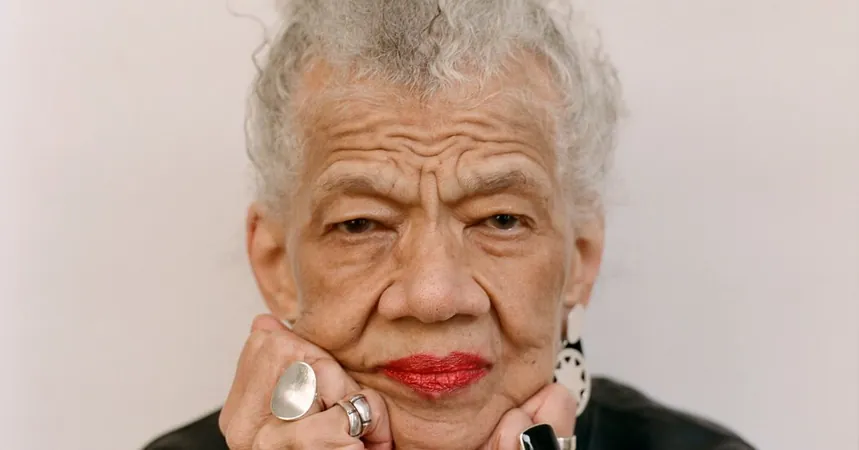
Lorraine O'Grady: The Visionary Artist Who Transformed the Landscape of Black Art, Passes Away at 90
2024-12-16
Author: Lok
Lorraine O'Grady, a trailblazing conceptual artist whose vibrant career spanned academia, rock criticism, and an impactful foray into the art world, has passed away at her Manhattan home at the age of 90. The news was confirmed by Robert Ransick of the Lorraine O’Grady Trust.
Early Life and Influences
Born on September 21, 1934, in Boston, O'Grady was the daughter of Jamaican immigrants who instilled a deep appreciation for education. Despite their formal qualifications, O’Grady’s parents faced systemic barriers that limited their professional opportunities—a legacy that shaped her pursuit of artistic expression amid racial and gender discrimination.
Artistic Journey
O'Grady's art defied categorization, embracing a plethora of mediums including collage, performance, video, and installation. Her work not only addressed the intersection of race and gender but also sought to navigate the unique challenges she faced as a Black woman in a predominantly white art world. For decades, she remained an underrecognized figure until her distinctive voice began to resonate with younger generations of Black artists.
Career Development
Her journey into the art world began later in life, after establishing herself as a research economist and literary translator. A turning point came after she moved to Europe to pursue her passion for writing, eventually leading her to Chicago, where she opened a translation agency that worked with prestigious clients.
Bold Performances and Impact
In the early 1980s, O'Grady made headlines with her bold performance art interventions. One landmark piece, performed as her alter ego “Mlle. Bourgeoise Noire,” took place at a prominent Black gallery where she challenged the audience with slogans like 'No more bootlicking!' while provocatively dressed in a gown crafted from hundreds of white gloves. This moment emphasized her calling for more audacious representations of Black art.
Cultural Reflections
O’Grady's works were not merely performance pieces; they were cultural reflections. In her notable 1982 performance 'Rivers, First Draft, or the Woman in Red,' she explored her autobiographical narrative in a compelling multimedia format. Her ability to intertwine personal history with communal storytelling positioned her as a critical voice in an era when Black avant-garde art was frequently dismissed.
Participatory Art and Community Engagement
Her innovative participatory piece, 'Art Is ...,' showcased at the Afro-American Day Parade in Harlem, turned spectators into art by inviting them to pose within empty gilded picture frames—an empowering celebration of community and identity that echoed through the years and even inspired political campaigns decades later.
Recognition and Retrospectives
As O'Grady's influence grew, academic circles embraced her scholarly contributions, particularly her seminal 1992 essay 'Olympia’s Maid: Reclaiming Black Female Subjectivity.' Exhibitions featuring her work gained traction, including significant showcases at the Museum of Contemporary Art in Los Angeles and the Brooklyn Museum.
Legacy and Continuing Influence
In recent years, O’Grady garnered recognition with various landmark exhibitions highlighting her work from 'WACK! Art and the Feminist Revolution' to the retrospective 'Lorraine O’Grady: Both/And.' This latter exhibition introduced new photographic series that reflected her continued evolution as an artist.
Her multifaceted legacy extends beyond her art. O’Grady's contributions to the discourse on Black identity and representation in art catalyzed other artists and industries to challenge the status quo. Her work continues to inspire and provoke important conversations about race, gender, and artistic freedom.
Conclusion
O’Grady's passing marks a significant loss, but her revolutionary spirit and pioneering ideas will undoubtedly continue to influence future generations of artists looking to navigate the complexities of identity and culture in their work. As the art world reflects on her profound contributions, one thing remains clear: Lorraine O’Grady was a force of nature whose life and work dismantled boundaries and created new pathways for artistic expression.



 Brasil (PT)
Brasil (PT)
 Canada (EN)
Canada (EN)
 Chile (ES)
Chile (ES)
 Česko (CS)
Česko (CS)
 대한민국 (KO)
대한민국 (KO)
 España (ES)
España (ES)
 France (FR)
France (FR)
 Hong Kong (EN)
Hong Kong (EN)
 Italia (IT)
Italia (IT)
 日本 (JA)
日本 (JA)
 Magyarország (HU)
Magyarország (HU)
 Norge (NO)
Norge (NO)
 Polska (PL)
Polska (PL)
 Schweiz (DE)
Schweiz (DE)
 Singapore (EN)
Singapore (EN)
 Sverige (SV)
Sverige (SV)
 Suomi (FI)
Suomi (FI)
 Türkiye (TR)
Türkiye (TR)
 الإمارات العربية المتحدة (AR)
الإمارات العربية المتحدة (AR)